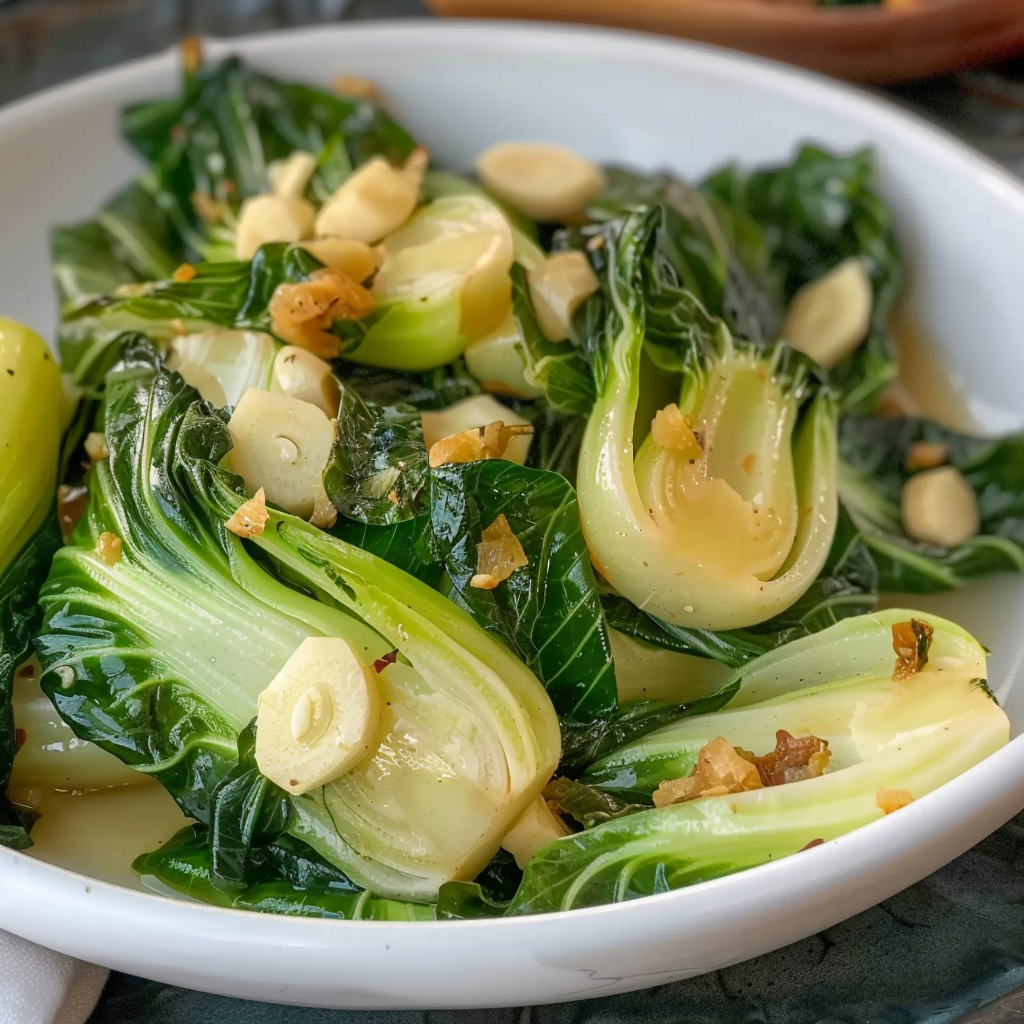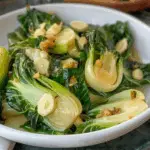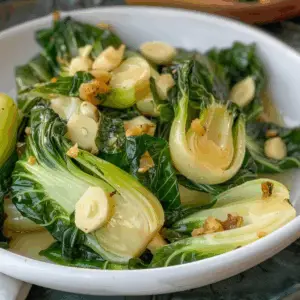1.Bok Choy and the Dish
Bok choy stir fry with garlic and ginger is one of the easiest and healthiest ways to bring Asian flavor into your kitchen. This vibrant green is part of the cruciferous vegetable family and delivers a tender yet crisp bite, especially when cooked using a high-heat stir-fry method. By combining it with fresh ginger and minced garlic, you create a bold, aromatic base that enhances the mild flavor of the bok choy without overpowering it.
This dish is also highly customizable. Whether you’re looking for a quick weeknight dinner, a healthy side, or a clean meal prep option, stir-fried bok choy offers versatility. It’s naturally vegan, can be made gluten-free with a simple soy sauce swap, and pairs well with grains, proteins, or even noodle bowls. You can even draw inspiration from healthy Asian stir fry meal prep ideas like this one on Pinterest to batch cook for the week.
In many traditional dishes, Asian greens like bok choy (Wikipedia) are used for their quick cooking time and nutrient density. The technique of stir-frying these greens with aromatics like ginger and garlic has been practiced in Chinese cuisine for generations. Today, it’s become a staple in modern kitchens for its simplicity, speed, and rich flavor. Adding a sprinkle of sesame seeds or a squeeze of lime at the end brings balance and texture to the dish. With just a handful of pantry staples, this easy veggie side delivers flavor and nutrition in every bite.
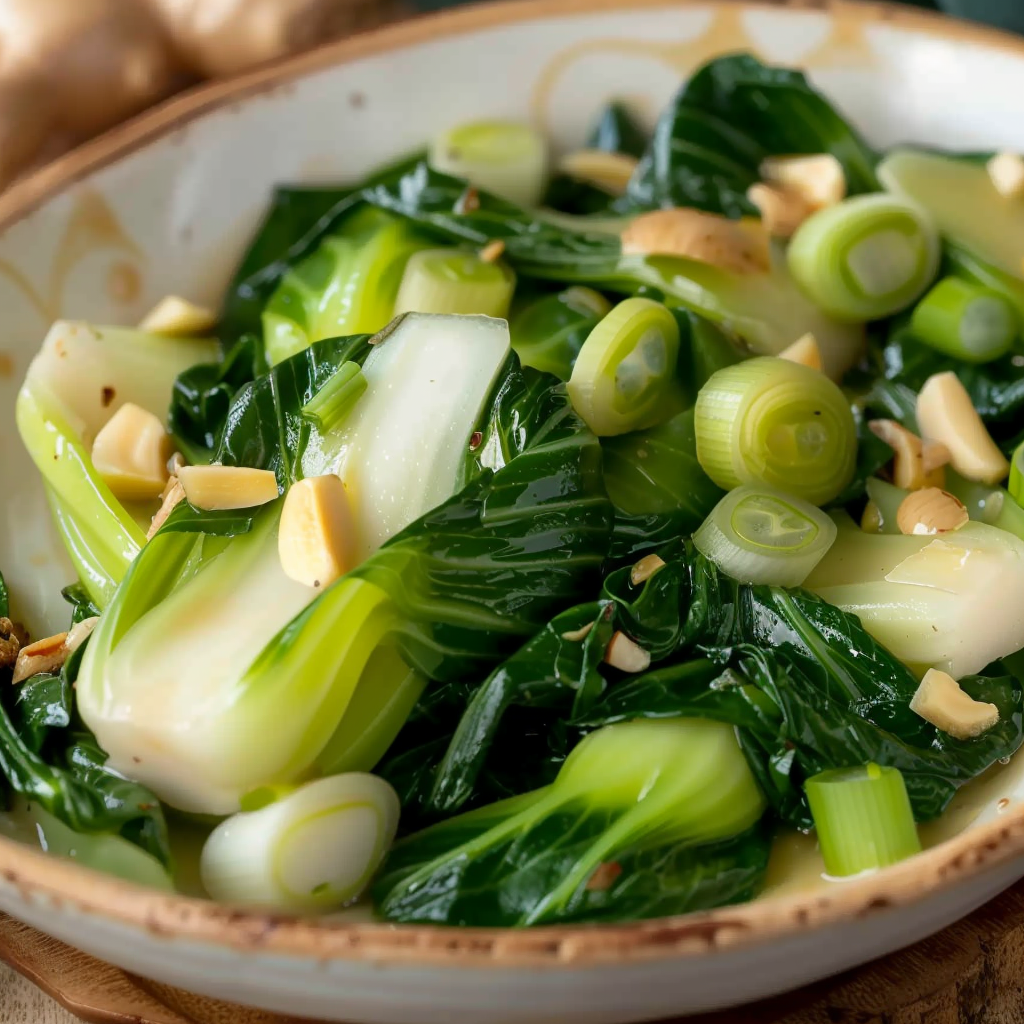
2. What is Bok Choy? A Quick Overview of This Asian Super Green
Bok choy, also known as pak choi or Chinese white cabbage, is a type of non-heading cabbage widely used in Asian cuisine. Its crisp white stalks and tender green leaves offer a satisfying contrast in both texture and taste. Originating from China, bok choy has long been a staple in stir-fries, soups, and steamed dishes thanks to its mild, slightly peppery flavor and quick cooking time.
There are two main types: regular bok choy and baby bok choy. The baby variety, which is often more tender and subtly sweet, is ideal for quick stir-fries like this recipe. Both versions belong to the Brassica family, which includes other nutrient-rich vegetables such as broccoli, kale, and cabbage. This makes bok choy not only versatile in the kitchen but also a nutritional powerhouse. It’s rich in vitamins A, C, and K, calcium, iron, and antioxidants, contributing to immune support and bone health.
Incorporating Asian greens like bok choy (Wikipedia) into your diet is a simple way to increase your intake of essential micronutrients. For those following plant-based, low-carb, or anti-inflammatory diets, bok choy provides bulk and nourishment without heaviness. It’s also commonly found in Chinese cabbage varieties (Wikipedia), which are similarly used in fast-cooked dishes due to their high water content and light flavor.
Whether you’re creating a quick stir-fry, adding it to a broth, or enjoying it as a side, bok choy adapts beautifully to a wide range of flavor profiles. It complements spicy, savory, or citrusy elements, which is why pairing it with ginger, garlic, and a splash of soy sauce makes for a perfectly balanced, clean-tasting dish.
3. Health Benefits of Ginger and Garlic in Veggie Dishes
Ginger and garlic are more than just flavor boosters—they’re functional foods with a long history in both culinary and medicinal traditions. In Asian cooking, especially in stir-fry dishes, these two ingredients are used together not only for their bold aroma but also for their wide range of health benefits.
Ginger, known for its warming spice and zesty aroma, contains the compound gingerol, which has powerful anti-inflammatory and antioxidant properties. It supports digestion, reduces nausea, and may help ease muscle soreness and joint pain. According to Wikipedia, ginger has been used in traditional medicine systems such as Ayurveda and Traditional Chinese Medicine for centuries due to its ability to stimulate circulation and detoxify the body. When added to a stir-fry, fresh grated ginger delivers heat and brightness that cuts through richer sauces and ingredients.
Garlic is another powerhouse ingredient. Rich in the compound allicin, garlic offers antimicrobial, antibacterial, and antifungal properties. It has been linked to improved heart health, reduced blood pressure, and stronger immune function. As Wikipedia explains, garlic’s sulfur compounds are responsible for its potent aroma and its wide range of protective effects on the body. In a stir-fry, minced garlic quickly caramelizes and creates a deep, savory base when cooked in oil.
Together, ginger and garlic create a flavor foundation that transforms a simple vegetable like bok choy into a deeply satisfying, aromatic dish. When used with healthy oils like sesame oil and mineral-rich soy sauce, this combination becomes a nutrient-dense, anti-inflammatory meal that’s perfect for anyone looking to eat clean, reduce processed food intake, and support whole-body wellness.
4. Ingredients Breakdown: Why Each Component Matters
Understanding each ingredient in a stir-fry helps you appreciate how flavors and textures come together in harmony. This dish relies on a few core pantry staples, but each plays a key role in creating a bold, healthy, and balanced meal.
-
Vegetable oil or sesame oil:
Your choice of oil affects both flavor and cooking performance. Vegetable oil has a neutral taste and a high smoke point, making it ideal for searing. Sesame oil, especially the toasted variety, adds a rich, nutty aroma and is commonly used in Asian cooking. If you’re aiming for a more authentic flavor, go with toasted sesame oil. -
Fresh garlic (4 cloves, minced):
Garlic forms the savory base of this stir fry. It caramelizes quickly in hot oil and infuses the dish with a deep, earthy aroma. Make sure to avoid burning it by adding it at the right time and stirring continuously—Wikipedia’s garlic entry discusses its use in various cooking methods. -
Fresh ginger (1 tablespoon, grated):
Ginger adds a peppery, citrusy heat that balances the richness of the garlic. It also contributes anti-inflammatory benefits of ginger (Wikipedia) and complements the crisp texture of bok choy. -
Baby bok choy (1½ pounds, halved lengthwise):
The star of the dish. When stir-fried correctly, baby bok choy offers a juicy crunch from the stalks and tender bite from the leaves. Always dry the bok choy thoroughly before cooking to avoid steaming instead of searing. -
Soy sauce (2 tablespoons):
This ingredient provides umami, saltiness, and depth. For a gluten-free version, consider substituting tamari (Wikipedia), which maintains the savory flavor without the wheat. -
Water (1 tablespoon):
Used to create steam when the pan is covered, helping the bok choy cook evenly and tenderize without getting soggy. -
Salt and black pepper:
These are simple seasonings to adjust the final flavor. Use sparingly, especially if your soy sauce is already salty. -
Optional: red pepper flakes, sesame seeds, lime juice:
These additions let you personalize the dish. Red pepper flakes add heat, sesame seeds (Wikipedia) offer texture and nutty flavor, and lime juice provides a tangy brightness to balance the savory elements.
By using high-quality ingredients and mastering the timing of when to add them, you can elevate a basic stir-fry into a clean, flavorful, and nutrient-packed dish. These components not only enhance taste but also contribute to a balanced meal that’s easy to digest and perfect for quick lunches, dinners, or even as part of a vegan stir fry dinner (Pinterest) meal prep plan.
5. Step-by-Step Stir Fry Technique (with Tips)
Perfecting the stir fry technique is the key to making bok choy with ginger and garlic come alive with texture and flavor. This section walks you through each step, highlighting the importance of timing, heat, and ingredient layering to avoid sogginess and bring out the best in your veggies.
-
Step 1: Heat the oil properly
Start with a large skillet or wok over medium-high heat. Add 1 tablespoon of vegetable oil or toasted sesame oil. Wait until the oil shimmers—this ensures it’s hot enough to sear. Heating oil properly is critical in any Asian stir fry, allowing aromatics to bloom without becoming greasy. -
Step 2: Add garlic and ginger
Once the oil is ready, add the minced garlic and grated ginger. Stir-fry for about 30 seconds, stirring constantly. You’ll smell their aromas immediately. Don’t walk away—these ingredients burn fast. If garlic burns, it turns bitter and ruins the dish. For more on avoiding this, check the tip on how to keep garlic from burning in stir fry in our FAQs section. -
Step 3: Sear the bok choy
Place the bok choy cut side down in the pan. Don’t overcrowd—work in batches if necessary. Let it cook undisturbed for 2–3 minutes. This creates a golden sear on the flat surface of the stalks, enhancing flavor and texture. It’s a crucial step to keep the bok choy from turning limp. -
Step 4: Flip and add liquid
Flip each piece of bok choy using tongs. Add 2 tablespoons of soy sauce and 1 tablespoon of water around the pan (not directly on the vegetables). Immediately cover with a lid to trap steam. Let it steam for another 2–3 minutes to cook the greens through. -
Step 5: Finish with seasoning and garnish
Uncover the pan and stir the bok choy to coat it evenly in the sauce. Add salt and black pepper to taste. Garnish with red pepper flakes for heat, sesame seeds for texture (Wikipedia – Sesame), or a squeeze of lime for brightness.
This method ensures that the white stalks stay crisp while the leaves become tender. The sauce clings lightly to the surface without drowning the vegetables, making the dish ideal for quick meals and healthy meal prep. You can also find plating inspiration on Pinterest’s ginger garlic stir fry ideas to serve this dish beautifully.
By mastering this simple timing-based technique, you’ll avoid soggy greens and unlock a restaurant-quality stir fry right from your own kitchen.
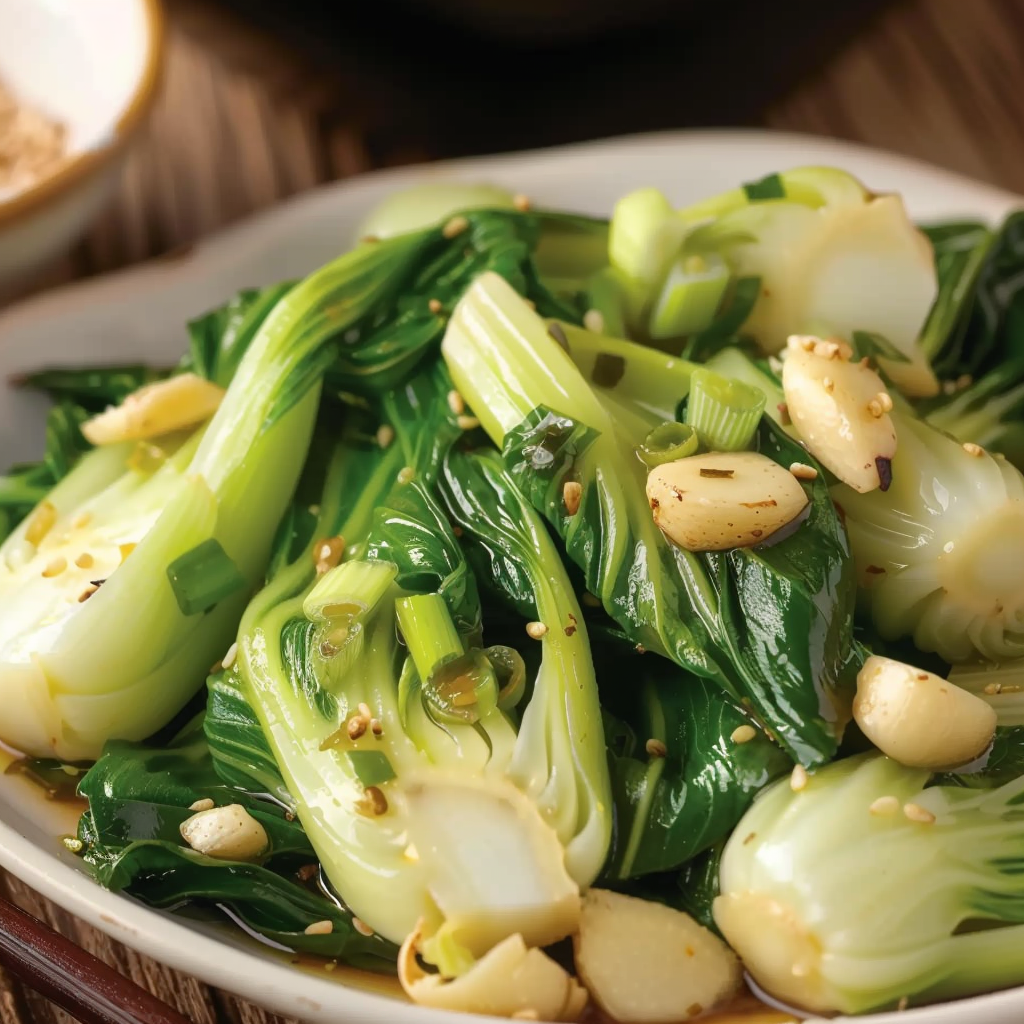
6. Recipe Variations and Add-Ons
One of the biggest advantages of this bok choy stir fry is its flexibility. Whether you’re trying to use what’s in your fridge or adapting it to dietary needs, this dish is a great base for creative variations. Here are some simple yet flavorful ways to make it your own:
-
Add Protein
Transform this from a side to a main dish by adding tofu, tempeh, or grilled chicken. Just sear your protein first, set it aside, and stir it back in during the final step to coat it with the sauce. -
Include More Veggies
Bulk up the stir-fry with vegetables like mushrooms, bell peppers, or snap peas. These additions add color, fiber, and even more nutrients. Add firmer vegetables early in the stir-fry process, and leafy ones later to preserve their texture. -
Make It Spicy
Add sliced Thai chilies, sriracha, or chili garlic sauce for extra heat. Stir it in with the garlic and ginger to release the full aroma. You can also finish the dish with red pepper flakes for a dry, smoky heat. -
Use Gluten-Free Options
Replace soy sauce with tamari or coconut aminos if you’re avoiding gluten. Both alternatives still provide that essential umami flavor. Learn more about tamari and its origins on Wikipedia. -
Try Other Asian Greens
Out of bok choy? Swap it with choy sum, napa cabbage, or even Chinese cabbage (Wikipedia). These greens cook similarly and deliver slightly different flavor profiles, making them great substitutes. -
Top with Crunch or Citrus
A sprinkle of toasted sesame seeds, a drizzle of sesame oil, or a squeeze of lime juice adds extra flavor and contrast. Refer to Pinterest’s easy vegetarian Asian dishes for topping ideas.
These variations keep the dish exciting and adaptable for different meals. You can serve it over rice, add it to noodles, or include it in a vegan stir fry dinner (Pinterest). It’s easy to scale up, prep ahead, and enjoy in different ways throughout the week.
7. What to Serve With Stir-Fried Bok Choy
While bok choy stir fry shines on its own, it pairs beautifully with a range of main dishes and carbs, making it a go-to side for fast, balanced meals. Here are some perfect pairings:
-
Serve with Rice
White rice, brown rice, or jasmine rice soak up the sauce beautifully and balance the crisp greens. -
Pair with Noodles
Try soba noodles, udon, or rice noodles for a satisfying meal. Toss the stir-fry right into the noodles with a little extra soy sauce or sesame oil. -
Add to Soup
Drop cooked bok choy into ramen or pho just before serving. The ginger and garlic flavors blend well into broth-based dishes. -
Complement with Proteins
Serve alongside grilled tofu, teriyaki salmon, chicken thighs, or shrimp. The stir-fry’s simple seasoning allows proteins to shine. -
Enjoy with Dumplings or Potstickers
The freshness of bok choy balances the rich filling of dumplings, creating a complete Asian-inspired plate.
These combinations offer a wide range of meal prep options, making the dish perfect for lunchboxes, quick dinners, or plant-based meal planning.
8. How to Meal Prep and Store Bok Choy Stir Fry
Bok choy stir fry is meal-prep friendly if stored and reheated properly. Here’s how to keep it fresh and flavorful:
-
Storage
Let the stir fry cool completely before placing it in an airtight container. Store in the refrigerator for up to 4 days. Avoid freezing—it can make the greens soggy. -
Portioning
Use glass meal prep containers to portion servings with rice or protein. This makes reheating easier and keeps everything fresh. -
Reheating Tips
Reheat in a skillet over medium heat to retain the texture. Add a splash of water or soy sauce if it looks dry. Avoid microwaving for too long, as it can wilt the greens. -
Undercook for Meal Prep
If you’re preparing several servings for the week, slightly undercook the bok choy. It will finish cooking when reheated, preserving its crisp texture.
This method works great for those inspired by healthy Asian stir fry meal prep ideas found on Pinterest. Add variety by changing your proteins or side dishes each day.
9. Common Mistakes When Stir-Frying Bok Choy (And How to Avoid Them)
Even simple dishes like stir-fried bok choy have pitfalls that can impact taste and texture. Here’s how to avoid common mistakes:
-
Overcrowding the Pan
Adding too much bok choy at once causes steaming instead of searing. Cook in batches if needed to allow even browning. -
Skipping the Drying Step
Wet bok choy will steam and become soggy. Always dry thoroughly after rinsing to ensure a good sear. -
Burning the Garlic or Ginger
These aromatics burn fast and become bitter. Always stir constantly and reduce heat if necessary during this step. You’ll find more guidance in the how do you keep garlic from burning FAQ below. -
Overcooking the Greens
Bok choy cooks quickly. Limit the steam time to 2–3 minutes to keep the stalks crisp and the leaves tender. -
Using Too Much Sauce
Excess soy sauce or water can drown the veggies. Stick to the measurements to avoid a watery dish.
By avoiding these mistakes, you’ll consistently achieve stir-fried bok choy with perfect texture, flavor, and appearance.
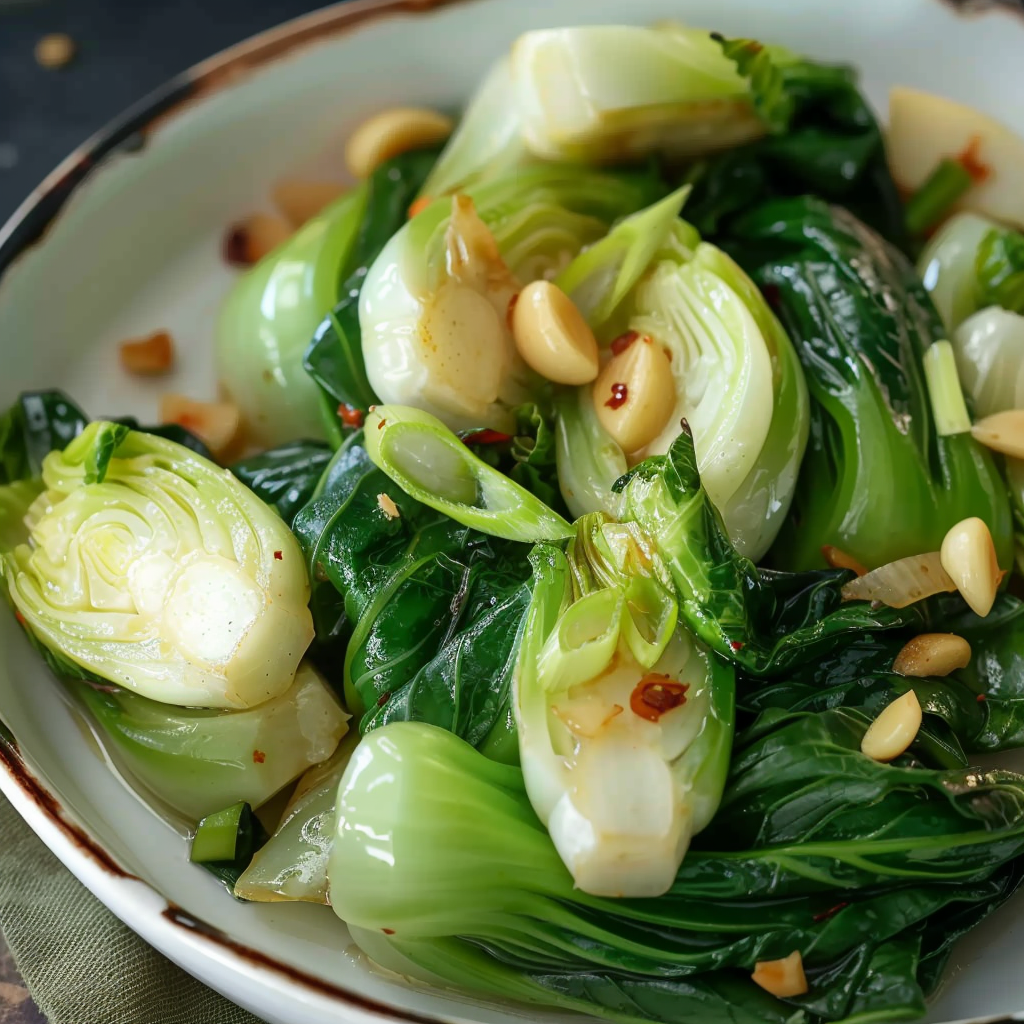
10. FAQs (Frequently Asked Questions)
Q1. Can you eat the white part of bok choy?
Yes, the white stalks of bok choy are not only edible but delicious. They add a satisfying crunch and hold up well to stir-frying. Be sure to sear them cut-side down for the best texture.
Q2. Do you need to blanch bok choy before stir-frying?
No, blanching is not necessary. Stir-frying directly preserves the nutrients and enhances the flavor. Blanching can lead to overcooking and soggy greens if not done carefully.
Q3. Is baby bok choy healthier than regular bok choy?
Both are rich in vitamins A, C, and K, calcium, and fiber. Baby bok choy is slightly more tender and may be easier to digest, but nutritionally, they’re very similar.
Q4. Can I use frozen bok choy?
It’s possible, but fresh bok choy is recommended for stir-fries. Frozen versions tend to release more water, leading to a softer, less crisp texture.
Q5. How do you keep garlic from burning in stir fry?
Add garlic once the oil is hot but not smoking. Stir continuously and keep the heat at medium-high, not full blast. You can also add it after ginger, which has slightly more moisture and helps prevent burning.
Easy Veggie Dishes How To Stir Fry Bok Choy With Ginger And Garlic
This stir-fried bok choy with ginger and garlic is a quick and healthy vegetable side that delivers bold Asian flavor in under 15 minutes. Crisp baby bok choy is seared until golden, then steamed lightly with soy sauce and aromatics for a tender yet crunchy finish. Topped with optional chili flakes or sesame seeds, this dish is ideal for plant-based meals, weeknight dinners, or flavorful lunch prep.
- Author: Clara
Ingredients
- 1 tablespoon vegetable oil or sesame oil
- 4 cloves garlic, minced
- 1 tablespoon fresh ginger, grated
- 1 ½ pounds baby bok choy, halved lengthwise
- 2 tablespoons soy sauce
- 1 tablespoon water
- Salt and black pepper to taste
- Optional: red pepper flakes or sesame seeds for garnish
Instructions
- Heat oil in a large skillet or wok over medium-high heat.
- Add the garlic and ginger, and stir-fry for about 30 seconds until fragrant.
- Add the bok choy, cut side down, and cook for 2–3 minutes without moving it, so it gets a light sear.
- Flip the bok choy, add soy sauce and water, and cover the pan with a lid.
- Steam for 2–3 minutes until the bok choy is tender but still crisp.
- Remove the lid and stir to coat with the sauce. Season with salt and black pepper to taste.
- Transfer to a serving dish and garnish with red pepper flakes or sesame seeds if desired. Serve warm.
Notes
-
Make it gluten-free: Use tamari or coconut aminos instead of soy sauce.
-
Storage tip: Best enjoyed fresh, but can be refrigerated up to 4 days.
-
Serving idea: Pairs perfectly with rice, noodles, tofu, or dumplings.
-
Spice it up: Add Thai chilies or sriracha for a kick of heat.
-
Avoid sogginess: Dry bok choy thoroughly and don’t overcrowd the pan.
